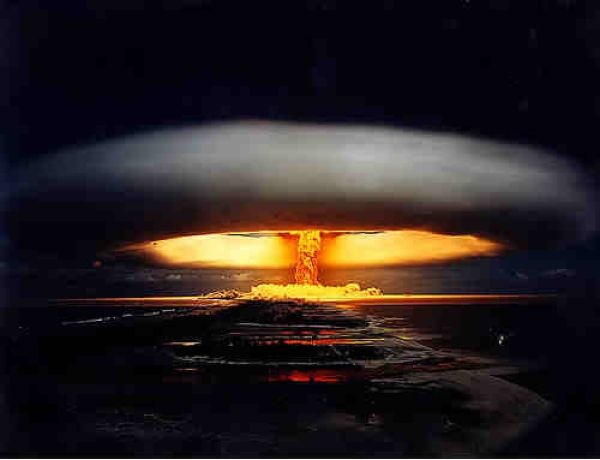India’s nuclear program had its inception in March 1944 by Dr. Homi Bhabha when he founded the nuclear research center, the Tata Institute of Fundamental Research in Mumbai. Homi Bhabha conceived the three-stage nuclear program as a way to develop India’s nuclear energy by working around India’s limited uranium resources. Here is a list about 30Important Facts on Indian Nuclear Program.
Nuclear Tests
1. India’s first successful nuclear detonation was called Operation Smiling Buddha that was tested in 1974 with a yield (8 kiloton) equivalent to half of the energy generated by Little Boy (atomic bomb dropped on Hiroshima).
2. The official number of Indian nuclear tests are 6 that were conducted under two different code-names and at different times, Operation Smiling Buddha (1 test) in 1974 and Operation Shakti (5 tests) in 1998.
3. Operation Shakti (Pokhran-II) was India’s first fusion bomb with an estimated yield of 58 kilotons.
4. India became sixth country to have tested nuclear bombs.
5. One of the testing shafts of the 1998 nuclear tests by India was code named “White House.”
Nuclear Reactors
6. India’s First Nuclear Reactor was Apsara. It was also the first nuclear reactor in Asia. Apsara went critical at Bhabha Atomic Research Centre (BARC), Trombay on August 4, 1956.
7. Tarapur Atomic Power Station (Maharashtra) was the first nuclear power plant in India. The construction of the plant was started in 1962 and the plant went operational in 1969.
8. All of the India’s Nuclear reactors currently use Uranium as its fuel, but India has only around 1‑2% of the global uranium reserves.
9. Nuclear energy constitutes only 2.9% of India’s total energy output produced by 20 nuclear reactors.
10. India’s primary weapons grade nuclear fuel is produced by BARC’s Dhruva Reactor in Trombay.
Thorium Research
11. The PFBR (Prototype Fast Breeder Reactor) nuclear reactor coming up in Kalpakkam (Tamil Nadu) is going to be India’s first reactor capable of using thorium as fuel. It is expected to be operational by September of 2014.
12. India leads the world in experiments with using thorium as a substitute nuclear fuel in nuclear reactors.
13. India has largest shares of global thorium reserves at about 30% of the total world thorium reserves in the sands of coastal regions of South India.
14. Indian nuclear scientists estimate that the country could produce 500 GWe for at least four centuries using just the country’s economically extractable thorium reserves (nearly 95 times India’s current energy production).
Nuclear Policies
15. Of the countries with nuclear weapons, only China, India, and North Korea have a declared “no first use” policy.
16. India is among four other countries (Israel, Pakistan, South Sudan being others) to not sign Treaty on the Non-Proliferation of Nuclear Weapons on grounds that the concept of the treat is flawed because it restricts the legal possession of nuclear weapons to those states that tested them before 1967, but the treaty never explains on what ethical grounds such a distinction is valid.
17. Because India is outside the Nuclear Non-Proliferation Treaty due to its weapons program, it was for 34 years largely excluded from trade in nuclear plant or materials, which has hampered its development of civil nuclear energy until 2009.
18. After Japan’s nuclear disaster in 2011, several countries have rethought the use of nuclear energy. For example, Germany plans to close all of its reactors by 2022. Italy and Switzerland have halted expanding their nuclear power. However, some big markets, such as China and India, are still pushing ahead with new nuclear plants.
Military Nuclear Might
19. India is estimated to have a total of 80 to 100 nuclear weapons in its arsenal. As of 1999, India was estimated to have 4200 kg of separated reactor-grade plutonium from its power reactors, which is equivalent to roughly 1000 nuclear weapons.
20. INS Arihant launched in 26 July 2009 is India’s first indigenously built nuclear submarine.
21. In INS Arihant’s estimated lifespan of 40 years, it will only be required to refuel once, midway through its lifecycle. Therefore its range is unlimited in terms of refuelling (limited only by food supply).
22. Only other Indian nuclear submarine is INS Chakra, which is an Akula Class submarine leased out to India from Russia (2011-2020).
23. India’s BrahMos supersonic cruise missile is considered the world’s fastest cruise missile capable of delivering a nuclear warhead up to 500 km away in just 8 minutes. BrahMos II under development is expected to do the same in just under 4 minutes.
Incidents
24. India has officially reported six nuclear accidents with no reported causalities any of the incidents.
25. An asteroid almost caused a nuclear war between India and Pakistan in 2002. Fortunately it exploded over Mediterranean Sea. If it would have occurred at the same latitude a few hours earlier, the explosion might have resembled a nuclear detonation equivalent to the blast that destroyed Hiroshima.
26. In June 2012, 38 workers were exposed to radiation when a welding operation went wrong inside the protected environment of the Rajasthan Atomic Power Station Reactor in Kota.
International Views
27. According to some American Scientists, “India has the most technically ambitious and innovative nuclear energy program in the world. The extent and functionality of its nuclear experimental facilities are matched only by those in Russia and are far ahead of what is left in the US.”
28. Recent studies undertaken by the CIA cites that chronic India-Pakistan conflict is a “flash point,” or a conflict most likely to lead to nuclear war. A second conflict would be the between U.S. and the People’s Republic of China over Taiwan.
Future
29. India is one of the seven participating countries assigned to develop a working model of the world’s first fusion reactor in France. Fusion reactors are expected to be clean and limitless sources of energy in the future.
30. Kudankulam Nuclear Power Plant will become the largest nuclear power generation complex in India producing a cumulative 2 GW of electric power when it becomes operational.







































